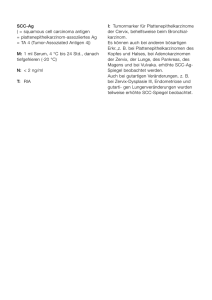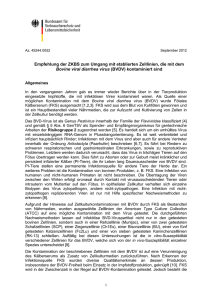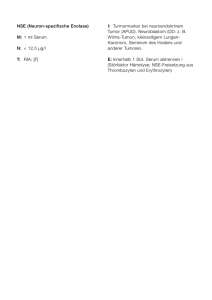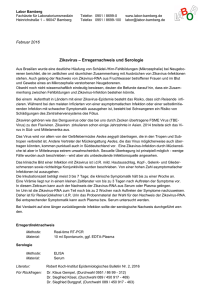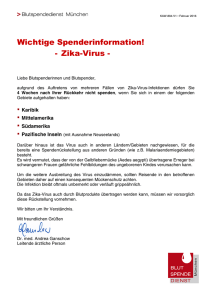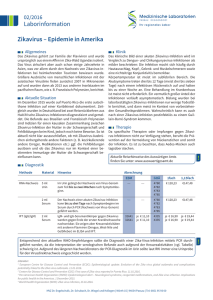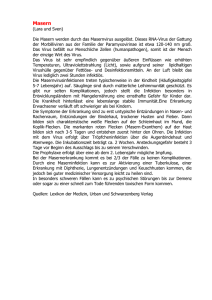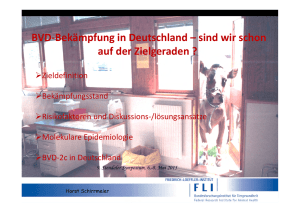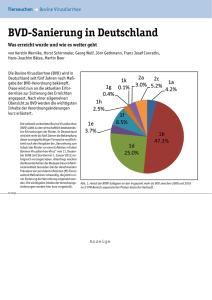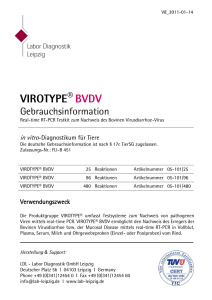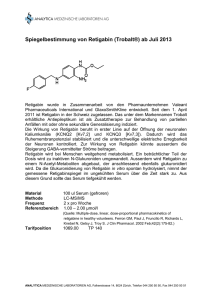Bovine Virus Diarrhoea Virus (BVDV-Ab)
Werbung
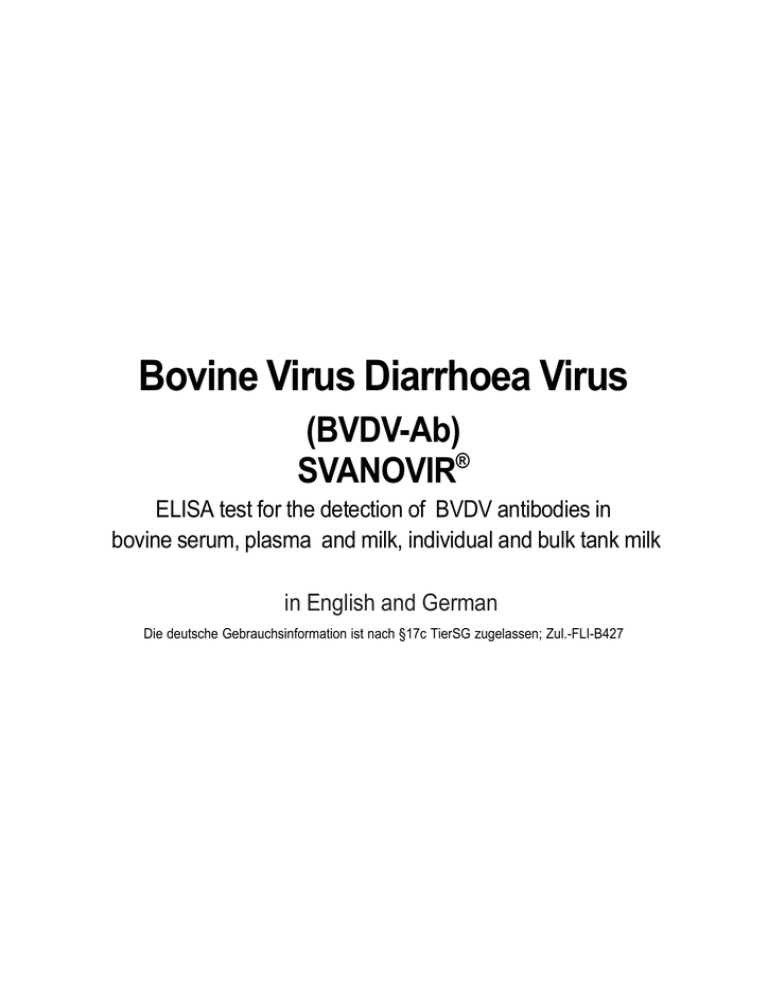
Bovine Virus Diarrhoea Virus (BVDV-Ab) SVANOVIR® ELISA test for the detection of BVDV antibodies in bovine serum, plasma and milk, individual and bulk tank milk in English and German Die deutsche Gebrauchsinformation ist nach §17c TierSG zugelassen; Zul.-FLI-B427 Contents/Zusammensetzung Contents/ Zusammensetzung BVDV antigen coated microtiter plates/strips; odd columns coated with viral antigen and even columns with control antigen Mikrotiterplatten (Streifen) beschichtet mit inaktivierten BVDV Antigen (Reihen 1,3,5,7,9,11) und mit Kontrollantigen (Reihen 2,4,6,8,10,12) Lyophilized HRP Conjugate (horseradish peroxidase conjugated anti-bovine IgG monoclonal antibodies) Anti-Rind-IgG-HRP Konjugat, lyophilisiert (jede Flasche 11,5ml nach Auflösen) PBS-Tween Solution 20 x concentrate PBS-Tween-Lösung, 20-fach konzentrierte Substrate Solution - (tetramethylbenzidine in substrate buffer containing H2O2) STORE IN THE DARK ! Art.. # 10-2200-02 Art. # 10-2200-10) 2 10 2 10 1x125ml 3x125ml 1x20ml 1x50ml 1x10ml 1x50ml 0,2ml 0,5ml 0,2ml 0,5ml 2,5ml 5ml 2,5ml 5ml Substrate-Lösung (tetramethylbenzidin und H202 gelöst in Substratpuffer) Stop Solution - Contains sulphuric acid- CORROSIVE! Stoplösung - 2M Schwefelsäure Positive Control Serum - 0,05% merthiolate Reagenz A, positives Kontrollserum konserviert mt 0,05% Mertiolat Negative Control Serum - 0,05% merthiolate Reagenz B, negatives Kontrollserum konserviert mt 0,05% Mertiolat Positive Control Milk - 0,05% merthiolate Reagenz C, positives Kontrollmilch konserviert mt 0,05% Mertiolat Negative Control Milk - 0,05% merthiolate Reagenz D, negatives Kontrollmilch konserviert mt 0,05% Mertiolat Bovine Virus Diarrhoea Virus (BVDV-Ab) SVANOVIR® ELISA test for the detection of BVDV antibodies in bovine serum, plasma and milk, individual and bulk tank milk General information Principle The Bovine Virus Diarrhoea Virus (BVDV), a pesti-virus, is associated with a range of diseases affecting the alimentary tract of cattle. Clinical signs include pyrexia, diarrhoea and reduced milk yield; there is a high morbidity but low mortality of infected animals1. Infection of pregnant cows may result in transplacental foetal infection. Foetuses may be aborted, mummified, stillborn or born with severe anomalies. However, in many instances calves, if immunotolerant, are born unaffected but with persistent viraemia and become transmission sources of the virus 2. Moreover, recurrent infection of such calves may result in mucosal disease3 – a condition with low morbidity but high mortality; it is characterized by extensive erosions in the oral and gastrointestinal mucosa. BVDV has also been shown to have immunosuppressive effects which predisposes animals to infection by other microorganisms 4 . Economic losses can be high due to these factors which is why herds should be monitored for the presence of infection. The SVANOVIR®BVDV-Ab ELISA Kit is designed to detect BVDV specific antibodies in serum or milk samples. The kit procedure is based on a solid phase indirect Enzyme Linked Immunosorbent Assay (Indirect ELISA). In this procedure, samples are exposed to noninfectious BVDV antigen coated wells on microtitre plates or strips. BVDV antibodies (if present in the test sample) bind to the antigens in the well. The HRP conjugate added subsequently forms a complex with these BVDV antibodies. Unbound material is removed by rinsing before the addition of a substrate solution. Subsequently a blue colour develops which is due to the conversion of the substrate by the conjugate. A positive result is indicated by development of the blue colour. The reaction is stopped by addition of stop solution; the colour changes to yellow. The result can be read visually or by a microplate photometer, where the optical density (OD) is measured at 450 nm. Recommendations! The volume of the reagents for product 10-2200-02 is sufficient for at least 8 separate occasions Strips with broken seal can be stored at +2 to +8 for up to 4 weeks. Reconstituted conjugate may not be stored in refrigerator. Materials needed but not provided 1. 2. 3. 4. 5. 6. Precision pipets (range from 4 to 200µl) Disposable pipet tips Distilled water Wash bottle 1 container: 1 to 2 litres for PBS-Tween Microplate photometer, 450 nm filter Specimen information Individual serum or pools up to 10 samples: 4µl alt 10µl of blood serum or plasma is needed for each sample well. Fresh, refrigerated, or previously frozen serum or plasma may be tested. Individual or pooled milk samples/bulk tank milk up to 50 animals: 100µl of skim milk is required for each sample well. It is recomended to centrifuge milk samples for 15 minutes at 2000 x g to remove the lipid layer, or leave the milk samples until the fat layer is formed on top of the sample. Pipette under the fat layer. Preparation of reagents PBS-Tween Buffer: Dilute the PBS-Tween Solution 20 x concentrate 1/20 in distilled water. Prepare 500 ml per plate by adding 25 ml PBST solution to 475 ml distilled water and mix thoroughly. N.B. Please check that there is no crystal precipitation in the bottle. If crystals are seen, please warm and shake well. Anti-Bovine IgG Conjugate: Reconstitute the lyophilized HRP Conjugate with 11.5 ml PBS-Tween Buffer. Add the buffer carefully to the bottle. Leave the solution one minute and mix thoroughly. Prepare immediately before use. The remaining reconstituted conjugate can be stored at -20°C and thawed and refrozen up to 3 times. Precautions 1. Carefully read and follow allinstructions. 2. Store the kit and all reagents at +2 to +8°C (35 to 45°F) 3. All reagents should equilibrate to room temperature +18 to +25°C (64 to 77°F) before use. 4. Handle all materials according to the Good Laboratory Practice. 5. Do not mix components or instruction booklets from different test kit batches. 6. Care should be taken to prevent con tamination of kit components. 7. Do not use test kit beyond date of expire. 8. Do not eat, drink, or smoke where specimens or kit reagents are handled. 9. Use a separate pipet tip for each sample. 10. Do not pipet by mouth. 11. Include positive and negative serum and/or milk controls on each plate or test strip series. 12. Use only distilled water for preparation of reagents. 13. The Stop Solution contains sulphuric acid, which is corrosive. 14. All unused biological materials should be disposed according to the local, regional and national regulations. Procedure 1. All reagents should equilibrate to room temperature 18 to 25°C (64 to 77°F) before use. Label each strip with a number. 2. Add samples. Serum Samples using 4µl sample volume A. Add 100µl of PBS-Tween Buffer to each well that will be used for serum samples and serum controls. B. Add 4µl of Positive Control Serum (Reagent A) and 4µl of Negative Control Serum (Reagent B) respectively to selected wells coated with BVDV viral antigen and to corresponding wells coated with control antigen. For confirmation purposes it is recommended to run the control sera in duplicates. C. Add 4µl of serum sample to a selected well coated with BVDV viral antigen and to a corresponding well coated with control antigen. For confirmation purposes it is recommended to run the samples in duplicates. D. Shake the plate thoroughly. Seal the plate/strip and incubate at 37°C (98.6°F) for 1 hour or over night (16-20h) at +4-8°C. Continue at step #3. Serum Samples using 10µl sample volume A. Add 90µl of PBS-Tween Buffer to each well that will be used for serum samples and serum controls. B. Add 10µl of Positive Control Serum (Reagent A) and 10µl of Negative Control Serum (Rea gent B) respectively to selected wells coated with BVDV viral antigen and to corresponding wells coated with control antigen. For confirmation purposes it is recommended to run the control sera in duplicates. C. Add 10µl of serum sample to a selected well coated with BVDV viral antigen and to a corresponding well coated with control antigen. For confirmation purposes it is recommended to run the samples in duplicates. D. Shake the plate thoroughly. Seal the plate/strip and incubate at 37°C (98.6°F) for 1 hour. Continue at step #3. Milk Samples A. Add 100µl of Positive Control Milk (Reagent C) and 100µl of Negative Control Milk (Reagent D) respectively, to selected wells coated with BVDV viral antigen and to corresponding wells coated with control antigen. For confirmation purposes it is recommended to run the control milk in duplicates. B. Add 100µl of skim milk sample to a selected well coated with BVDV viral antigen and to a corresponding well coated with control antigen. For confirmation purposes it is recommended to run the samples in duplicates. D. Shake the plate thoroughly. Seal the plate/strip and incubate at 37°C (98.6°F) for 1 hour or over night (16-20h) at +4-8°C. Continue at step #3. 3. Rinse the plates/strips 3 times with PBS-Tween Buffer: at each rinse cycle fill up the wells, empty the plate and tap hard to remove all remains of fluid. 4. Add 100µl of HRP Conjugate to each well and incubate at 37°C (98.6°F) for 1 hour. 5. Repeat step #3. 6. Add 100µl Substrate Solution to each well. Incubate for 10 minutes at room temperature (18 to 25°C). Begin timing when the first well is filled. 7. Stop the reaction by adding 50µl of Stop Solution to each well and mix thoroughly. Add the Stop Solution in the same order as the Substrate Solution in step #6. 8. Measure the optical density (OD) of the controls and samples at 450 nm in a microplate photometer (use air as blank). Measure the OD Measure the OD within 15 minutes after the addition of Stop Solution to prevent fluctuation in OD values. Calculations Calculation of results are done in two steps as described below. 1. Corrected OD Values (ODCorr) The optical density (OD) values in wells coated with BVDV viral antigen are corrected by subtracting the OD values of the corresponding wells containing the control antigen. ODBVDV - ODControl= ODCorr 2. Percent Positivity Values (PP) All Corrected OD Values for the test samples as well as the Negative Control (Neg C) are related to the corrected OD value of the positive control as follows: PP = Test Sample or Neg C (ODCorr) x 100 Positive Control (ODCorr) Interpretation of the results Criteria for test validity To ensure validity, the duplicate of the OD values should not differ more than 25% from the mean value of the two duplicates. Additionally, the control values should fall within the following limits; ODCorr Positive control > 1,0 ODCorr Negative control < 0,15 Should any of these criteria not be fulfilled, the test is invalid. For invalid tests, technique may be suspect and the assay should be repeated. Interpretation-individual samples Short incubation Sample PP Interpretation Serum (4µl sample volume) < 14 > 14 Negative Serum (10µl sample volume) < 10 > 10 and < 25 > 25 Negative Doubtful Positive <7 >7 Negative Positive PP Interpretation Milk Positive Over Night Incubation Sample Serum (4µl sample volume) Milk < 19 > 19 <9 >9 Negative Positive Negative Positive Interpretation of tank milk samples according to the Swedish National Programme When testing samples from bulk tank milk it is possible to assess the status of the herd as follows: BVD Class Classification PP values 0 und e te ctab le / lo w le ve l o f antib o d ie s 0-2 1 lo w le ve l o f antib o d ie s 3-13 2 me d ium to hig h le ve ls 14-29 3 me d ium to hig h le ve ls 30 References 1. Barber,D.M.L., Nettleton, P.F., and Herring, J.A. (1985) Disease in a dairy herd associated with the introduction and spread of bovine virus diarrhoea virus. Vet. Rec. 2, 459-464. 2. Van Oirschot, J.T. (1983) Congenital infections with nonarbo togaviruses. Vet Microbiol. 8, 321-361. 3. Howard, C.J., Brownlie, J. and Clarke, M.C. (1987). Comparision by the neutralization assays of pairs of noncytopathogenic and cytopathogenic strains of bovine virus diarrhoea virus isolated from cases of mucosal disease. Vet. Microbiol. 13, 361-369. 4. Reggiardo, C.,and Kaeberle, M.L. (1981) Detection of bacteremia in cattle inoculated with bovine viral diarrhoea virus. The Am. J. of Vet. Res. 42, 218-221. 5. Juntti, N., Larsson, B., and Fossum, C. (1987) The use of monoclonal antibodies in enzyme linked immunosorbent assays for detection of antibodies to bovine viral diarrhoea virus. J. Vet. Med. B 34, 356-363. 6. Niskanen, R., Alenius, S., Larsson, B., and Juntti, N. (1989) Evaluation of an enzyme- linked immunosorbent assay for the detection of antibodies to bovine virus diarrhoea virus in milk. J.Vet. Med. B 36, 113-118. Bovine Virus Diarrhoea Virus (BVDV-Ak) SVANOVIR® In vitro-Diagnostikum zum Nachweis von Antikörpern gegen das Virus der Bovinen Virus Diarrhöe im Blutserum , Blutplasma, Einzelmilch und Tankmilch von Rindern Die deutsche Gebrauchsinformation ist nach §17c TierSG zugelassen; Zul.-FLI-B427 Allgemeine Information Das Bovine Virus Diarrhöe Virus (BVDV), ein Pesti-Virus aus der Familie der Flaviviren, verursacht beim Rind und bei anderen Klauentieren eine Reihe von Erkrankungen mit sehr variablem Krankheitsbild. Innerhalb des Genus werden 2 Genotypen (Genotyp 1 und Genotyp 2) und zwei Biotypen (zytopathogener- und nichtzytopathogener Biotyp) unterschieden. Der Krankheitsverlauf ist von vielen Faktoren, vor allem aber von der Virulenz des jeweiligen Erregers und vom Infektionszeitpunkt, abhängig. Die transiente Infektion immunkompetenter Tiere führt zu einer vorübergehenden Darmerkrankung (Bovine Virusdiarrhöe), die mit einer zeitweiligen Immundepression einhergehen kann. Die Mortalität dieser Erkrankung ist gering, sie führt in der Regel zu Serokonversion mit Viruselimination und anschließender Immunität. In seltenen Fällen werden hämorrhagische Verlaufsformen mit hoher Mortalität bei Kälbern beobachtet. Die Infektion seronegativer, trächtiger Tiere führt regelmäßig zur diaplazentaren Infektion der Frucht mit unterschiedlichen Folgen, die vom Biotyp des Erregers und dem Trächtigkeitsstadium zum Zeitpunkt der Infektion bestimmt werden. Häufig kommt es zu Aborten, Umrindern und später zur Geburt lebensschwacher oder mißgebildeter Kälber. Bei Infektion in den ersten Monaten der Trächtigkeit kann beim Fötus eine persistierende Infektion mit lebenslanger, spezifischer Immuntoleranz entstehen. Diese Tiere sind nach der Geburt häufig klinisch unauffällig, oder sie bleiben im Wachstum zurück und kümmern. Als persistent infizierte Tiere scheiden sie lebenslang Virus aus und bilden in der Regel keine oder nur geringe Mengen spezifischer Antikörper. Nach endogener Mutation des Virus oder nach Superinfektion mit einem zytopathogenen Biotyp kann das Krankheitsbild der Mucosal Disease in mehr oder weniger charakteristischer Ausprägung entstehen, das mit hoher Mortalität verbunden ist. Persistent infizierte Tiere sind als Virusreservoir und Quelle ständiger Neuinfektionen in den Rinderbeständen anzusehen. Mit dem SVANOVIR ® BVDV-Ak können Antikörper gegen beide Genotypen und beide Biotypen des BVD-Virus nachgewiesen werden. Aufgrund der spezifischen Immuntoleranz ist ein negatives Ergebnis bei Einzeltieren von geringer Aussagekraft, zur Abklärung des Infektionsstatus ist zusätzlich ein Virus- oder Antigennachweis erforderlich. Dagegen erlaubt die serologische Untersuchung einer größeren Gruppe von Tieren Rückschlüsse auf das Infektionsgeschehen im Bestand. Besonders aufschlußreich ist die Untersuchung mehrerer Tiere im Alter von 9-24 Monaten. Nach Abbau der maternalen Antikörper sollten diese Tiere seronegativ sein, bei positiven Befunden im sogenannten ”Jungtierfenster” ist mit der Existenz von persistent infizierten Virusausscheidern in der Herde zu rechnen. Die Bestandsmilchuntersuchung ermöglicht eine rasche Orientierung über den serologischen Status der Kuhherde. Diagnostisches Verfahren Das SVANOVIR® BVDV-Ak, ein ”indirekter ELISA”, weist spezifische Antikörper gegen BVDV im Blutserum bzw. -plasma, sowie Einzelmilch und Tankmilch von Rindern nach. In den Reaktionsvertiefungen fixiertes inaktiviertes Antigen bindet in der zu testenden Probe vorhandene Antikörper gegen das BVD-Virus. Die zuzuführenden monoklonalen Antikörper sind mit Meerrettichperoxydase (HRP) konjugiert. Sie bilden einen Komplex mit den gebundenen BVDVAntikörpern. Ungebundenes Material wird durch einen Waschvorgang weggespült. Danach zugeführtes Substrat reagiert mit dem HRP-Konjugat. Es kommt zu einer Farbreaktion, der Test ist positiv. Sind in der zu testenden Probe keine meßbaren Antikörper gegen das BVD-Virus, so kann sich nach Hinzufügen des HRP-Konjugats kein Komplex bilden, es wird weggewaschen. Das danach zugefügte Substrat wird nicht gespalten. Es kommt zu keiner Farbreaktion, der Test ist negativ. Zusätzlich notwendiges Material 1. 2. 3. 4. 5. Präzisionspipetten (im Bereich von 10-200µl) Einmalpipettenspitzen Destilliertes Wasser Waschflasche Zwei Behälter: für Waschlösung (1bis 2 Liter) für Substratlösung (20 ml) 6. Photometer für Mikrotiterplatten mit 450 nm Filter 7. Einrichtung zum Aufbringen und Absaugen der Waschlösung. Besondere Hinweise 1. Alle Hinweise vor der Testdurchführung sorgfältig lesen und befolgen. 2. Das Test-Kit und alle Reagenzien bei +2 bis +8°C lagern. 3. Alle Reagenzien vor Gebrauch auf Zimmertemperatur (+18 bis +25°C) bringen. 4. Alle Materialen als potentiell infektiös behandeln und entsorgen. 5. Nicht die Reagenzien und/oder Anweisungen verschiedener Tests untereinander vertauschen. 6. Kontamination der Testreagenzien verhindern. 7. Test nach Ablauf der Haltbarkeit nicht mehr verwenden. 8. Während der Testdurchführung nicht essen, trinken oder rauchen. 9. Für jede Probe eine separate Pipettenspitze benutzen. 10. Nicht mit dem Mund pipettieren. 11. Bei jeder Testdurchführung muß eine positive und negative Kontrolle mitgeführt werden. 12. Ausschließlich destilliertes Wasser zur Herstellung der Testreagentien verwenden. 13. Die Stoplösung enthält Schwefelsäure, eine starke Säure, die schwere Verletzungen verursachen kann. Erhöhte Vorsicht ! 14. Alles biologische Material vor Entsorgung unschädlich machen (z. B. durch Autoklavieren). Art der Anwendung Verwendung der Mikrotiterplatten: Mit jeder Mikrotiterplatte können 44 Proben (bei Einfachansatz der Proben und Doppelansatz der Kontrollseren/Kontrollmilch) untersucht werden. Nach Öffnung der Umhüllung können die Streifen 4 Wochen bei +4-8°C aufbewahrt werden. Zubereitung der Testreagenzien: Wasch-/Konjugatsverdünnungs-Lösung: Für die Bearbeitung einer Mikrotiterplatte verdünnen Sie 25 ml des 20-fach-Konzentrates mit 475 ml destilliertem Wasser. Mischen Sie sorgfältig! Der Puffer kann, bei -20°C eingefroren, 3 Monate aufbewahrt werden. Konjugat: Lösen Sie pro Mikrotiterplatte 1 Flasche des lyophilisierten HRP-Konjugats mit 11,5 ml der Wasch-/Konjugatverdünnungs-Lösung auf. Die Lösung kann, bei -20°C eingefroren und bis zu dreimal aufgetaut und wieder eingefroren werden. Vernichten Sie den unverbrauchten Rest. Probenvorbereitung: Es kann frisches, kühl aufbewahrtes oder auch aufgetautes Blutserum oder -plasma und frische, kühl aufbewahrte oder auch aufgetaute entrahmte Milch benutzt werden. Auch z.B. mit Natriumacid konservierte Proben können untersucht werden. Inbesondere Milchproben sollten bei einer Lagerungszeit von mehr als einer Woche bei -20°C eingefroren werden. Pro Probe werden für jede Reaktionsvertiefung 10µl Blutserum/-plasma bzw. 100µl Milch benötigt. Durchfürung des Tests 1 2. 3. 4. 5. Alle Reagenzien sollen Raumtemperatur (+18 bis +25°C) haben. Entnehmen Sie die benötigte Anzahl der Mikrotiterplatten der Umhüllung. Die Platten sollten trocken sein. Blutserum/-plasma: Geben Sie in jede der für die Kontrollseren (Reagenz A und B) und Serumproben vorgesehenen Reaktionsvertiefunge 90µl der Wasch-/Verdünnungs-Lösung. Geben Sie 10µl des positiven Kontrollserums (Reagenz A) in die dafür vorgesehenen Reaktionsvertiefungen beschichtet mit BVDV Antigen und die entsprechenden Reaktionsvertiefungen beschichtet mit Kontrollantigen. Doppelansatz ist emphohlen. Verfahren Sie entsprechend mit dem negativen Kontrollserum. Geben Sie je 10µl der Serumproben in die dafür vorgesehenen Reaktionsvertiefungen beschichtet mit BVDV Antigen und die entsprechenden Reaktionsvertiefungen beschichtet mit Kontrollantigen. Fahren Sie mit der weiteren Durchführung des Tests fort, wie ab Punkt 5 beschrieben. Einzel-/Tankmilch: Geben Sie 100µl der positiven Kontrollmilch (Reagenz C) in die dafür vorgesehene Reaktionsvertiefungen) mit BVDV Antigen und die entsprechenden Reaktionsvertiefungen beschichtet mit Kontrollantigen. Doppelansatz ist emphohlen. Verfahren Sie entsprechend mit der negativen Kontrollmilch. Geben Sie je 100µl der Milchproben in die dafür vorgesehenen Reaktionsvertiefungen beschichtet mit BVDV Antigen und die entsprechenden Reaktionsvertiefungen beschichtet mit Kontrollantigen.. Verkleben Sie die Mikrotiterplatte und inkubieren Sie anschließend 60 Minuten bei 37°C oder alternativ bei 4°C über Nacht. 6. Entleeren Sie danach die Reaktions-vertiefungen und spülen Sie diese dreimal mit der Wasch-/ Verdünnungs-Lösung (mind. 300 µl pro Vertiefung), entfernen Sie dann die Flüssigkeit gründlich. 7. Geben Sie in jede Reaktionsvertiefung 100 µl des HRP-Konjugats. 8. Verkleben Sie die Mikrotiterplatte und inkubieren Sie 60 Minuten bei 37°C. 9. Wiederholen Sie den Vorgang, der in Punkt 6 beschrieben wurde. 10.Setzen Sie jeder Reaktionsvertiefung 100µl der Substratlösung zu und inkubieren Sie 10 Minuten bei Raumtemperatur (18 - 25°C). Beginnen Sie mit der Zeitmessung nach Füllen der ersten Reaktionsvertiefung. 11.Geben Sie 50 µl Stoplösung (Schwefelsäure) Vorsicht ätzend! - in jede Reaktionsvertiefung und zwar in der gleichen Reihenfolge, in der Sie die Substratlösung zugegeben hatten. 12.Messen Sie die Extinktionswerte (OD) der Serum Proben und Kontrollen sofort (innerhalb von 15 Minuten nach dem Zusatz der Stoplösung) mit einem Photometer bei 450 nm. Die Interpretation der Ergebnisse finden Sie später. Auswertung der Ergebnisse 1. Korrektur der Extinktionswerte: Die OD-Werte der Proben und Kontrollen müssen vor der Auswertung korrigiert werden, indem die korrespondierenden Werte aus den Reaktionsvertiefungen mit Kontrollantigen abgezogen werden. OD BVDV-Ag-OD Kontroll-Ag=OD Korrigiert 2. Validerung des Tests: Bedrechnen Sie den Mittelwerte der korrigierten OD-Werte(xODKorrigiert)der Kontrollen und gegebenenfalls der Proben. Bewertung der Ergebnisse: Die Höhe des PP-Wertes korrelliert mit der Höhe des Antikörpertiters. Blutserum-plasma PP < 10 Negativ d.h. kein meßbarer Antikörpertiter vorhanden, persistierende BVD-Infektion möglich. PP >10 und < 25 Schwach positiv d.h. niedriger Antikörpertiter vorhanden; persistierende BVD-Infektion kann nicht ausgeschlossen werden. PP > 25 Positiv Folgende Richtwerte dienen zur Überprüfung der d.h. das Tier ist immunkompetent, persistierende BVDInfektion unwahrscheinlich. korrekten Testdurchführung Einzelmilch Negatives Kontrollserum xODkorrigiert < 0,15 Positives Kontrollserum xODkorrigiert > 1,00 Negatives Kontrollmilch xODkorrigiert < 0,10 Positives Kontrollmilch xODkorrigiert PP < 5: Negativ d.h. kein meßbarer Antikörpertiter vorhanden, persistierende BVD-Infektion möglich. PP >5 und < 10 Schwach positiv d.h. niedriger Antikörpertiter vorhanden; persistierende BVD-Infektion kann nicht ausgeschlossen werden. PP >10 Positiv > 1,00 d.h. das Tier ist immunkompetent, persistierende BVD3. Berechnung des Prozentsatzes der OD-Werte PP Infektion unwahrscheinlich. der Proben: Tankmilch PP < 5: Negativ Die Extinktionswerte der Proben werden in % des Extinktionswertes der positiven Kontrolle (= 100 %) d.h. unter den laktierenden Tieren der Herde befinden sich ausgedrückt. keine oder nur vereinzelte seropositive Tiere. Eine länger Dazu benutzen Sie bitte die folgende Formel: andauernde persistierende BVDV-Infektion in der Herde ist mit hoher Wahrscheinlichkeit ausgeschlossen. ODkorrigiert der Probe = PP x100 PP >5 und < 10 Schwach positiv xODkorrigiert der positiven Kontrolle d.h. der überwiegende Teil unter den laktierenden Kühen der Herde ist seronegativ. Eine persistierende BVDVInfektion im Bestand ist unwahrscheinlich. PP >10 Positiv d.h. im Bestand haben Infektionen mit BVDV stattgefunden oder es wurde gegen BVDV vakziniert. Eine persistierende BVDV-Infektion in der Herde ist nicht auszuschließen. Zur Abklärung sind serologische und gegebenenfalls virologische Untersuchungen erforderlich. Customer Service Phone +46 18 65 49 15 Fax +46 18 65 49 99 [email protected] Manualnumber: 19-2200-00-22/04 Manufacturer / Hersteller/ Vertreib Svanova Biotech AB Uppsala Science Park SE-751 83 Uppsala, Sweden Phone +46 18 65 49 00 Fax +46 18 65 49 99 [email protected] www.svanova.com
